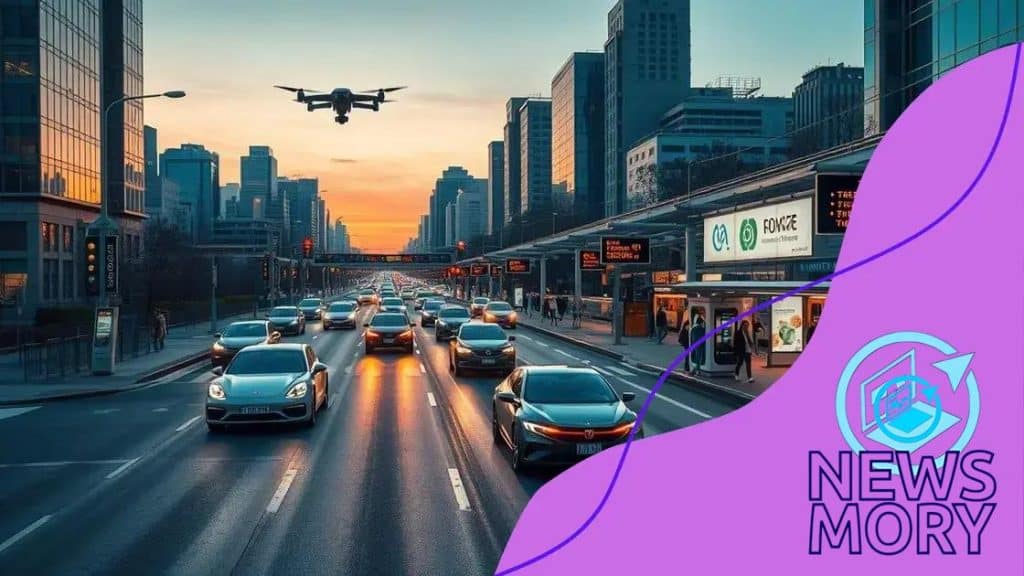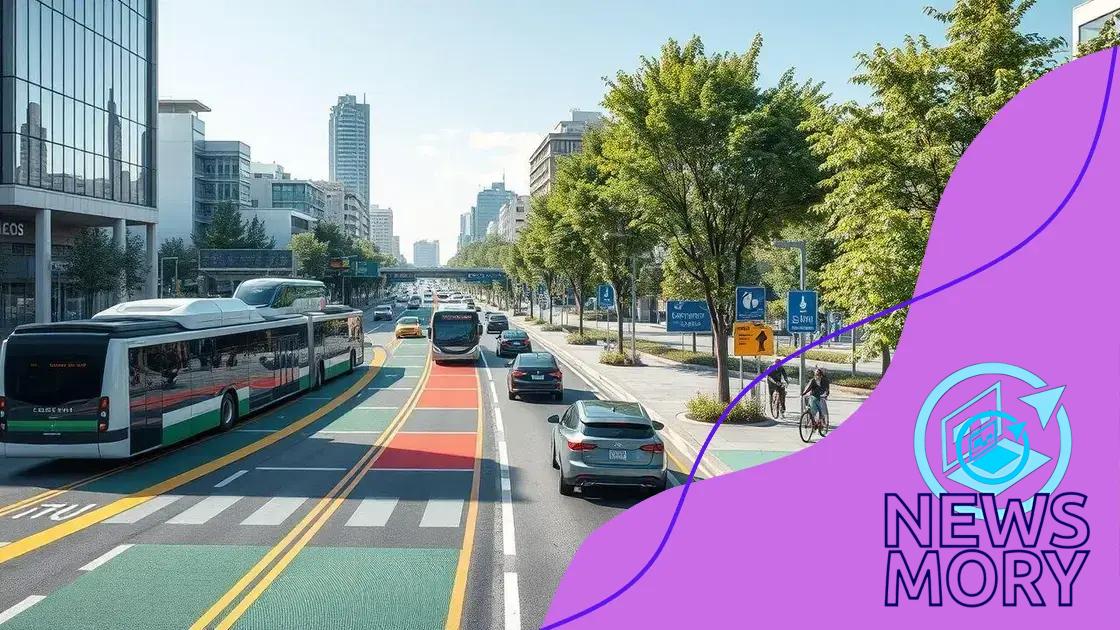Smart transportation systems and their impact on urban mobility

Anúncios
Smart transportation systems improve urban mobility by enhancing traffic management, reducing congestion, and promoting sustainable transport options, though they face challenges such as funding and public acceptance.
Smart transportation systems and their impact on urban mobility can reshape the way we navigate our cities. Have you ever wondered how technology could make your daily commute easier and more efficient? Let’s dive into this intriguing topic.
Anúncios
Understanding smart transportation systems
Smart transportation systems are revolutionizing how we move through our cities. These technologies are designed to improve traffic flow, reduce congestion, and enhance safety. By understanding these systems, we can make our daily commutes smoother and more efficient.
What Are Smart Transportation Systems?
Smart transportation systems combine information technology with transportation infrastructure. They use data from various sources to optimize traffic management and improve the travel experience for citizens. Real-time data communication allows for immediate responses to traffic conditions.
- Dynamic traffic signal control
- Real-time tracking of public transportation
- Smart parking solutions
- Vehicle-to-everything (V2X) communication
These systems not only enhance mobility but also promote sustainability. With the rise of electric vehicles, smart systems can integrate charging stations into urban planning, making it easier for users to adopt greener transportation methods.
Anúncios
Benefits of Understanding Smart Transportation
Understanding how these systems work empowers individuals and communities. It helps citizens recognize their role in promoting mobility solutions that are efficient and environmentally friendly. When people use systems like public transit effectively, they contribute to less traffic and lower emissions.
- Enhanced public safety
- Reduced traffic accidents
- Improved air quality
- Greater access to transportation for all
As smart transportation systems develop further, they will likely integrate more advanced technologies like artificial intelligence and machine learning. These advancements can predict traffic patterns and further enhance efficiency. By adapting our infrastructure to include these systems, urban areas can become more livable.
The role of technology in urban mobility
The role of technology in urban mobility is becoming increasingly crucial. As cities grow, managing transport efficiently is vital. Technology helps streamline this process by improving how we travel.
Innovative Technologies in Urban Mobility
New technologies are reshaping urban transport systems. For instance, smart traffic management systems are using real-time data to adjust traffic lights. This can significantly reduce waiting times at intersections, easing congestion for drivers.
- Real-time public transportation updates
- Mobile apps for ride-sharing services
- Data analytics for traffic flow optimization
- Sensors for vehicle health monitoring
Apps designed for urban mobility connect users with various transportation options. They provide details about public transport schedules and alternative commuting methods. This support encourages people to choose public transport over personal vehicles, leading to less traffic and lower emissions.
The Impact on Daily Commuting
With technology improving urban transport, daily commuting is evolving. From bike-sharing programs to electric scooters, technology offers diverse options for getting around. These modes are often faster and cheaper than traditional methods.
Moreover, technology aids in planning travel routes efficiently. For instance, navigation apps now include options that avoid traffic jams and construction delays, thus providing the fastest routes. By leveraging such technologies, urban residents can save time and enjoy smoother commutes.
Integrating electric vehicle (EV) infrastructure is another technology-driven change. With charging stations strategically placed throughout cities, residents can adopt cleaner transportation methods effortlessly. This integration supports both sustainability and convenience, making it easier for everyone to transition to greener options.
Benefits of smart transportation for cities

Understanding the benefits of smart transportation for cities is essential as urban areas grow and evolve. These systems not only improve mobility but also contribute to a more sustainable and livable environment.
Enhanced Efficiency in Traffic Management
Smart transportation systems significantly enhance traffic management. Technologies like real-time data and adaptive traffic signals help manage traffic flow more effectively. By analyzing data, cities can prevent congestion and reduce commute times for everyone.
- Improved access to real-time information
- Faster response to traffic incidents
- Reduction in idle time at signals
- Increased overall road efficiency
Furthermore, public transportation becomes more reliable. With updated schedules and real-time tracking, people can plan their trips better, encouraging higher public transport use. This transition leads to less reliance on personal vehicles, reducing traffic congestion and pollution.
Environmental Sustainability
Another significant benefit is the positive impact on the environment. By promoting public transport and lessening the number of cars on the road, smart transportation systems help improve air quality. Fewer vehicles lead to decreased greenhouse gas emissions, contributing to a cleaner atmosphere.
Additionally, integrating electric vehicles for public transport can further reduce the carbon footprint of urban transit. Cities can implement infrastructure for charging stations, making it easier for people to shift to more sustainable options.
With smart transportation, cities can also design pedestrian-friendly landscapes. By prioritizing walkability in urban planning, cities can ensure that residents have safe and convenient ways to travel without a vehicle.
Economic Advantages
Implementing smart transportation systems also yields economic benefits. Efficient transit systems attract businesses and tourism. When transport is easy, people are more likely to visit urban areas, boosting the local economy. Moreover, savings from decreased transportation-related costs can be redirected into local development projects.
Investing in smart transportation technology creates jobs in the technology and infrastructure sectors. As urban areas adopt these advanced systems, the demand for skilled workers increases, benefiting the local job market.
Challenges of implementing smart transportation
Understanding the challenges of implementing smart transportation is crucial for cities aiming to adopt these technologies. While the benefits are significant, there are hurdles that must be addressed to ensure successful integration.
Funding and Investment
One major challenge is securing adequate funding for smart transportation projects. Cities often face tight budgets and competing priorities, making it difficult to allocate resources for such advancements. Governments might need to seek public-private partnerships to share costs and risks associated with these projects.
- Finding sustainable funding models
- Engaging with private sector stakeholders
- Navigating political hurdles
- Ensuring transparency in budgeting
Furthermore, initial investments in technology can be high. While these systems often lead to long-term savings, the upfront costs can deter potential adopters.
Data Privacy and Security
As smart transportation systems collect vast amounts of data, ensuring data privacy and security is vital. Protecting user information and maintaining trust is essential for public acceptance. Cities must implement rigorous cybersecurity measures to safeguard sensitive data.
If individuals feel their data is not secure, they may be reluctant to engage with smart transportation solutions. Thus, educating the public on how data is used and protected is necessary for fostering willingness to adopt these technologies.
Public Resistance and Change Management
Implementing new technologies can also meet resistance from the public. Changing the status quo can be challenging, especially in communities accustomed to traditional transportation methods. Cities need to actively involve the community in discussions about new systems.
Open communication campaigns can help ease fears and misconceptions. Education on how smart transportation improves daily commuting will be vital for public acceptance. Additionally, involving communities in the planning process fosters a sense of ownership, encouraging acceptance of new systems.
Future trends in urban mobility systems
Exploring future trends in urban mobility systems reveals exciting advancements on the horizon. As technology evolves, cities are keen to adopt innovative solutions that enhance the quality of life for residents.
Autonomous Transportation
One major trend is the growth of autonomous vehicles. Self-driving cars and buses have the potential to transform urban transport. With advanced sensor technologies and AI, these vehicles can navigate streets with minimal human intervention, making roads safer.
- Reduced traffic accidents
- Increased accessibility for people with disabilities
- Optimized traffic flow
- Environmental benefits with electric autonomous vehicles
As cities implement dedicated lanes for autonomous vehicles, public acceptance will be crucial. Community education campaigns will play a significant role in overcoming skepticism around self-driving technology.
Shared Mobility Solutions
Another prominent trend is the rise of shared mobility services. Ride-sharing and bike-sharing programs are expanding quickly. These solutions encourage residents to use public transport instead of personal vehicles, reducing traffic and carbon emissions.
As urban areas invest in infrastructure to support these services, they can design efficient networks that integrate various modes of transport. This will not only improve accessibility but also promote a more sustainable approach to urban mobility.
Sustainable Practices and Green Transportation
With a growing emphasis on environmental responsibility, cities are prioritizing sustainable practices in their transport systems. The integration of electric vehicle (EV) charging stations is set to increase. Urban planners are focusing on making cities more walkable and bike-friendly.
By investing in green infrastructure, cities can reduce their carbon footprint while enhancing public health. This shift towards sustainability aligns with global efforts to combat climate change and promote healthier commuting options.
FAQ – Frequently Asked Questions about Smart Transportation Systems
What are smart transportation systems?
Smart transportation systems use technology to improve traffic management, safety, and efficiency in urban mobility.
How do autonomous vehicles benefit urban mobility?
Autonomous vehicles can reduce traffic accidents, improve efficiency, and provide mobility options for those unable to drive.
What challenges do cities face when implementing smart transportation?
Key challenges include securing funding, ensuring data privacy, addressing public resistance, and building necessary infrastructure.
What future trends can we expect in urban transportation?
We can expect growth in autonomous vehicles, shared mobility services, and an emphasis on sustainable and green transportation methods.





